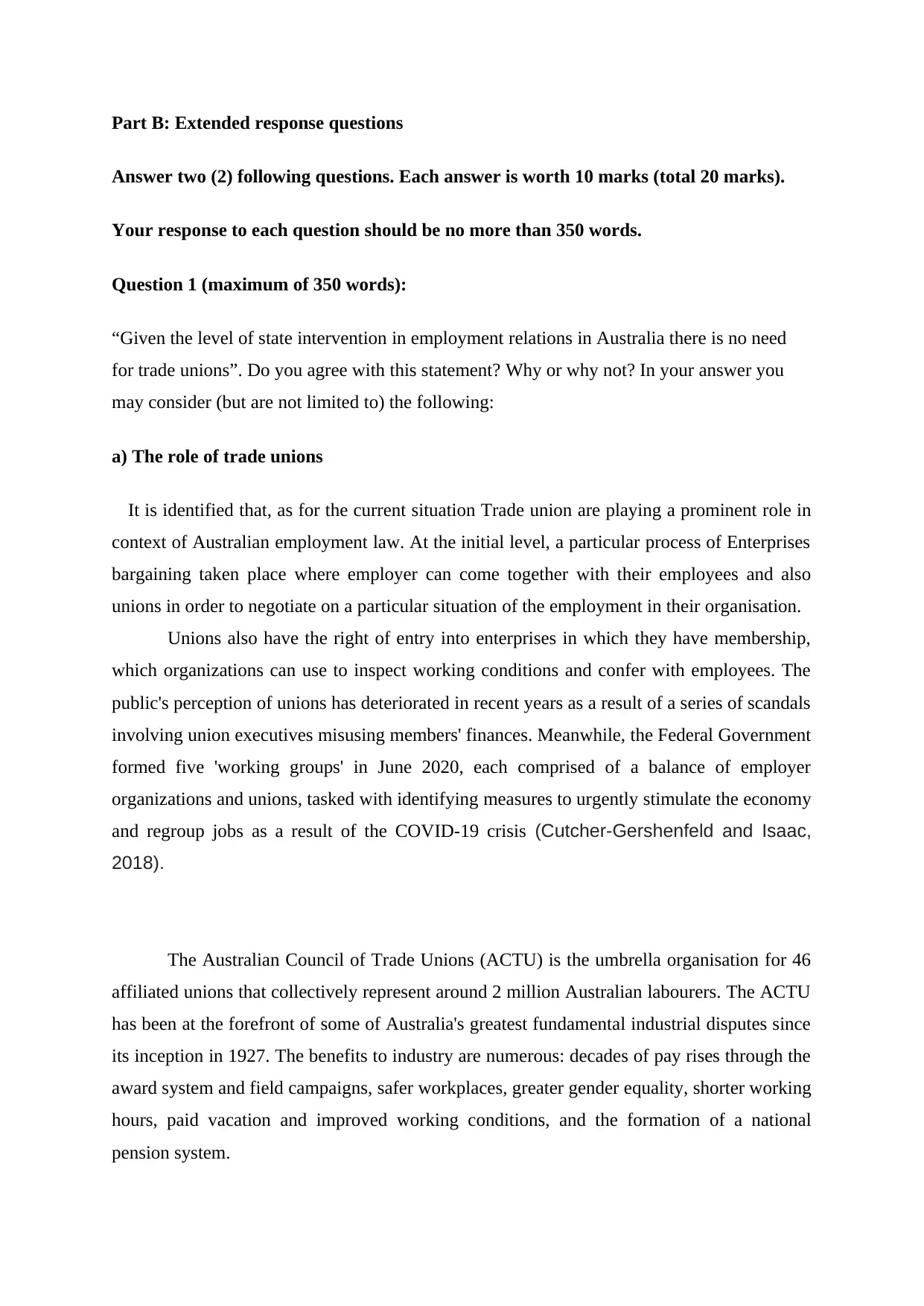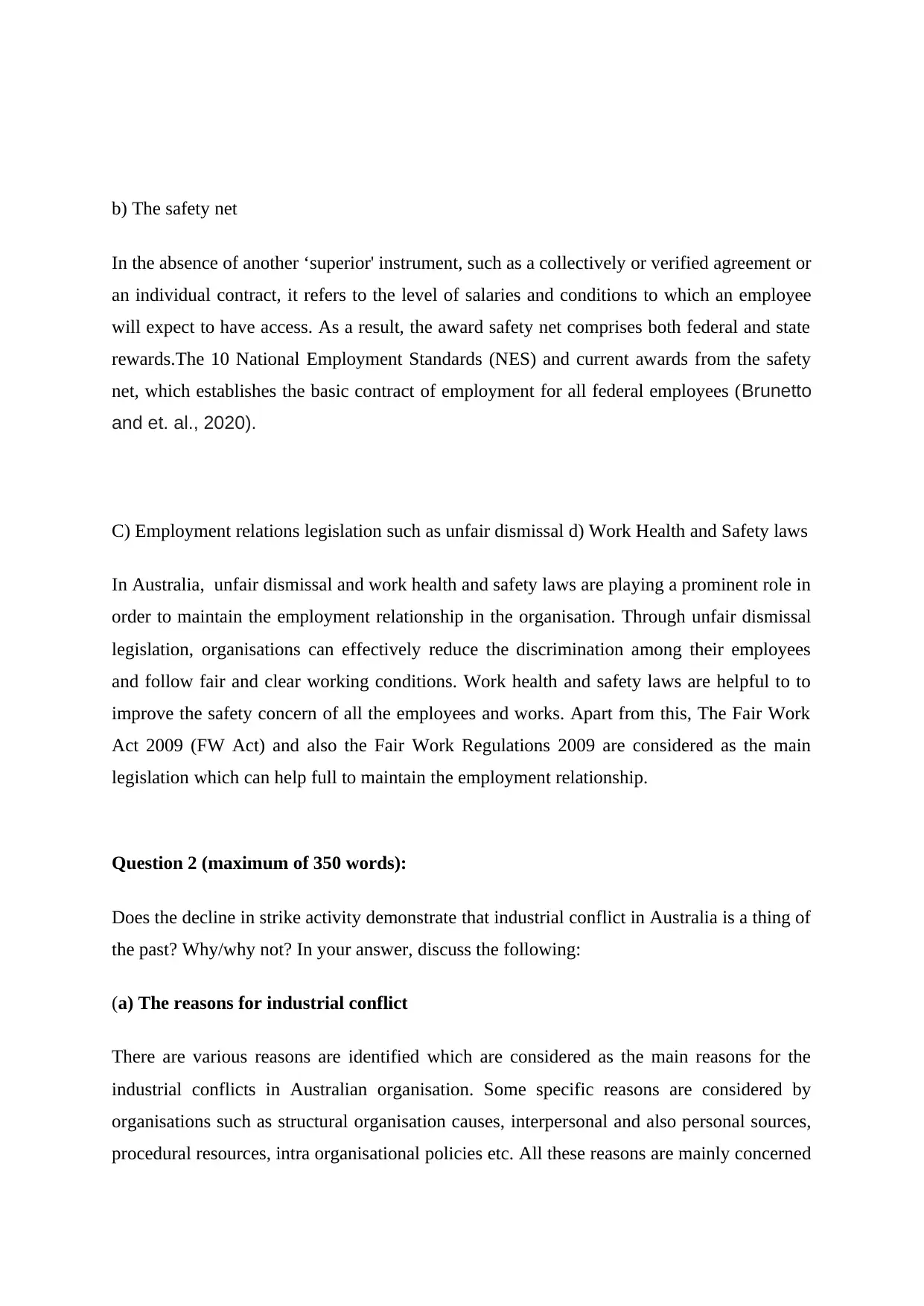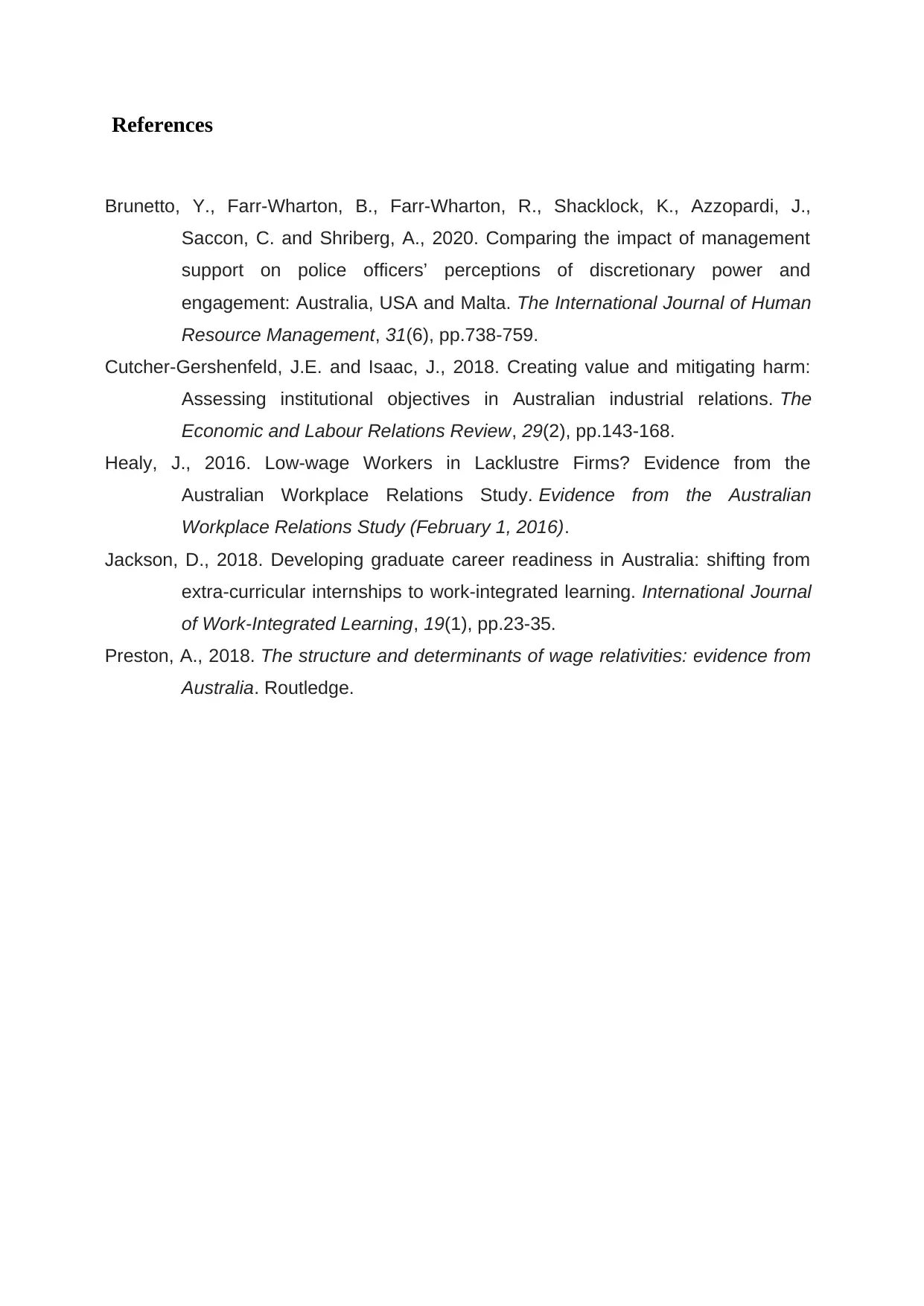Analyzing Trade Unions, Legislation, and Conflict in Australia ER
VerifiedAdded on 2023/06/16
|4
|1234
|175
Homework Assignment
AI Summary
This assignment delves into the Australian employment relations landscape, examining the role of trade unions, the impact of legislation, and the dynamics of industrial conflict. It addresses whether the level of state intervention negates the need for trade unions, considering their role in enterprise bargaining, workplace safety, and the safety net provided by awards and the National Employment Standards. The assignment also explores the reasons for industrial conflict, restrictions on strike activity under current legislation, and other forms of industrial action, ultimately questioning whether the decline in strikes signifies the end of industrial conflict in Australia. The Fair Work Act 2009 and related regulations are highlighted as key legislation shaping employment relationships. The assignment also identifies various reasons for industrial disputes, such as structural organizational causes, interpersonal issues, procedural resources, and intra-organizational policies, alongside factors like workload, low pay, and lack of communication.

Part B: Extended response questions
Answer two (2) following questions. Each answer is worth 10 marks (total 20 marks).
Your response to each question should be no more than 350 words.
Question 1 (maximum of 350 words):
“Given the level of state intervention in employment relations in Australia there is no need
for trade unions”. Do you agree with this statement? Why or why not? In your answer you
may consider (but are not limited to) the following:
a) The role of trade unions
It is identified that, as for the current situation Trade union are playing a prominent role in
context of Australian employment law. At the initial level, a particular process of Enterprises
bargaining taken place where employer can come together with their employees and also
unions in order to negotiate on a particular situation of the employment in their organisation.
Unions also have the right of entry into enterprises in which they have membership,
which organizations can use to inspect working conditions and confer with employees. The
public's perception of unions has deteriorated in recent years as a result of a series of scandals
involving union executives misusing members' finances. Meanwhile, the Federal Government
formed five 'working groups' in June 2020, each comprised of a balance of employer
organizations and unions, tasked with identifying measures to urgently stimulate the economy
and regroup jobs as a result of the COVID-19 crisis (Cutcher-Gershenfeld and Isaac,
2018).
The Australian Council of Trade Unions (ACTU) is the umbrella organisation for 46
affiliated unions that collectively represent around 2 million Australian labourers. The ACTU
has been at the forefront of some of Australia's greatest fundamental industrial disputes since
its inception in 1927. The benefits to industry are numerous: decades of pay rises through the
award system and field campaigns, safer workplaces, greater gender equality, shorter working
hours, paid vacation and improved working conditions, and the formation of a national
pension system.
Answer two (2) following questions. Each answer is worth 10 marks (total 20 marks).
Your response to each question should be no more than 350 words.
Question 1 (maximum of 350 words):
“Given the level of state intervention in employment relations in Australia there is no need
for trade unions”. Do you agree with this statement? Why or why not? In your answer you
may consider (but are not limited to) the following:
a) The role of trade unions
It is identified that, as for the current situation Trade union are playing a prominent role in
context of Australian employment law. At the initial level, a particular process of Enterprises
bargaining taken place where employer can come together with their employees and also
unions in order to negotiate on a particular situation of the employment in their organisation.
Unions also have the right of entry into enterprises in which they have membership,
which organizations can use to inspect working conditions and confer with employees. The
public's perception of unions has deteriorated in recent years as a result of a series of scandals
involving union executives misusing members' finances. Meanwhile, the Federal Government
formed five 'working groups' in June 2020, each comprised of a balance of employer
organizations and unions, tasked with identifying measures to urgently stimulate the economy
and regroup jobs as a result of the COVID-19 crisis (Cutcher-Gershenfeld and Isaac,
2018).
The Australian Council of Trade Unions (ACTU) is the umbrella organisation for 46
affiliated unions that collectively represent around 2 million Australian labourers. The ACTU
has been at the forefront of some of Australia's greatest fundamental industrial disputes since
its inception in 1927. The benefits to industry are numerous: decades of pay rises through the
award system and field campaigns, safer workplaces, greater gender equality, shorter working
hours, paid vacation and improved working conditions, and the formation of a national
pension system.
Paraphrase This Document
Need a fresh take? Get an instant paraphrase of this document with our AI Paraphraser

b) The safety net
In the absence of another ‘superior' instrument, such as a collectively or verified agreement or
an individual contract, it refers to the level of salaries and conditions to which an employee
will expect to have access. As a result, the award safety net comprises both federal and state
rewards.The 10 National Employment Standards (NES) and current awards from the safety
net, which establishes the basic contract of employment for all federal employees (Brunetto
and et. al., 2020).
C) Employment relations legislation such as unfair dismissal d) Work Health and Safety laws
In Australia, unfair dismissal and work health and safety laws are playing a prominent role in
order to maintain the employment relationship in the organisation. Through unfair dismissal
legislation, organisations can effectively reduce the discrimination among their employees
and follow fair and clear working conditions. Work health and safety laws are helpful to to
improve the safety concern of all the employees and works. Apart from this, The Fair Work
Act 2009 (FW Act) and also the Fair Work Regulations 2009 are considered as the main
legislation which can help full to maintain the employment relationship.
Question 2 (maximum of 350 words):
Does the decline in strike activity demonstrate that industrial conflict in Australia is a thing of
the past? Why/why not? In your answer, discuss the following:
(a) The reasons for industrial conflict
There are various reasons are identified which are considered as the main reasons for the
industrial conflicts in Australian organisation. Some specific reasons are considered by
organisations such as structural organisation causes, interpersonal and also personal sources,
procedural resources, intra organisational policies etc. All these reasons are mainly concerned
In the absence of another ‘superior' instrument, such as a collectively or verified agreement or
an individual contract, it refers to the level of salaries and conditions to which an employee
will expect to have access. As a result, the award safety net comprises both federal and state
rewards.The 10 National Employment Standards (NES) and current awards from the safety
net, which establishes the basic contract of employment for all federal employees (Brunetto
and et. al., 2020).
C) Employment relations legislation such as unfair dismissal d) Work Health and Safety laws
In Australia, unfair dismissal and work health and safety laws are playing a prominent role in
order to maintain the employment relationship in the organisation. Through unfair dismissal
legislation, organisations can effectively reduce the discrimination among their employees
and follow fair and clear working conditions. Work health and safety laws are helpful to to
improve the safety concern of all the employees and works. Apart from this, The Fair Work
Act 2009 (FW Act) and also the Fair Work Regulations 2009 are considered as the main
legislation which can help full to maintain the employment relationship.
Question 2 (maximum of 350 words):
Does the decline in strike activity demonstrate that industrial conflict in Australia is a thing of
the past? Why/why not? In your answer, discuss the following:
(a) The reasons for industrial conflict
There are various reasons are identified which are considered as the main reasons for the
industrial conflicts in Australian organisation. Some specific reasons are considered by
organisations such as structural organisation causes, interpersonal and also personal sources,
procedural resources, intra organisational policies etc. All these reasons are mainly concerned

about most of the organisation so that they can easily resolve all the conflicts situations.
There are another reasons are also identified by the organizations such as strikes, workload,
low pay scale, look outs, lack of communication, lack of resources, lack of Management
support etc.
(b) Restrictions on overt forms of industrial action such as strikes under the current
Legislation
Australian employees' access to the right to strike has been limited as a result of two recent
judgements in Australia. The judgements make it more difficult to engage in valid strike
action, and they increase the likelihood that lawful strike action will be blocked if it has a
negative impact on community members. The debate will begin by laying out the legal
provisions governing access to the right to strike in Australia, followed by a review of the
available developments to show how access to the right to strike has been severely harmed.
13Sydney Trains is the second major case affecting access to the right to strike in Australia. 7
Sydney Trains is the organization in charge of the train network in Sydney's suburbs.
Employees of Sydney Trains are represented by the Australian Rail, Tram & Bus Industry
Union (RTBU). The RTBU announced protected industrial action in the form of extended
overtime prohibitions and a 24-hour work stoppage during lengthy negotiations for a new
enterprise agreement. However, before the action could begin, Sydney Trains filed a
complaint with the FWC, asking for the protected industrial action to be suspended (Healy,
2016).
(c) Other forms of industrial conflict
There are various forms or industrial conflicts are indentified such as Strikes, Lockouts,
Picketing, Gherao, Strikes, Lay Off, Retrenchment . It is also determined that wages demand,
union rivalry, political interferences, unfair labor practices and multiplicity of labor laws are
also considered as the another industrial issues (Jackson, 2018).
There are another reasons are also identified by the organizations such as strikes, workload,
low pay scale, look outs, lack of communication, lack of resources, lack of Management
support etc.
(b) Restrictions on overt forms of industrial action such as strikes under the current
Legislation
Australian employees' access to the right to strike has been limited as a result of two recent
judgements in Australia. The judgements make it more difficult to engage in valid strike
action, and they increase the likelihood that lawful strike action will be blocked if it has a
negative impact on community members. The debate will begin by laying out the legal
provisions governing access to the right to strike in Australia, followed by a review of the
available developments to show how access to the right to strike has been severely harmed.
13Sydney Trains is the second major case affecting access to the right to strike in Australia. 7
Sydney Trains is the organization in charge of the train network in Sydney's suburbs.
Employees of Sydney Trains are represented by the Australian Rail, Tram & Bus Industry
Union (RTBU). The RTBU announced protected industrial action in the form of extended
overtime prohibitions and a 24-hour work stoppage during lengthy negotiations for a new
enterprise agreement. However, before the action could begin, Sydney Trains filed a
complaint with the FWC, asking for the protected industrial action to be suspended (Healy,
2016).
(c) Other forms of industrial conflict
There are various forms or industrial conflicts are indentified such as Strikes, Lockouts,
Picketing, Gherao, Strikes, Lay Off, Retrenchment . It is also determined that wages demand,
union rivalry, political interferences, unfair labor practices and multiplicity of labor laws are
also considered as the another industrial issues (Jackson, 2018).
⊘ This is a preview!⊘
Do you want full access?
Subscribe today to unlock all pages.

Trusted by 1+ million students worldwide

References
Brunetto, Y., Farr-Wharton, B., Farr-Wharton, R., Shacklock, K., Azzopardi, J.,
Saccon, C. and Shriberg, A., 2020. Comparing the impact of management
support on police officers’ perceptions of discretionary power and
engagement: Australia, USA and Malta. The International Journal of Human
Resource Management, 31(6), pp.738-759.
Cutcher-Gershenfeld, J.E. and Isaac, J., 2018. Creating value and mitigating harm:
Assessing institutional objectives in Australian industrial relations. The
Economic and Labour Relations Review, 29(2), pp.143-168.
Healy, J., 2016. Low-wage Workers in Lacklustre Firms? Evidence from the
Australian Workplace Relations Study. Evidence from the Australian
Workplace Relations Study (February 1, 2016).
Jackson, D., 2018. Developing graduate career readiness in Australia: shifting from
extra-curricular internships to work-integrated learning. International Journal
of Work-Integrated Learning, 19(1), pp.23-35.
Preston, A., 2018. The structure and determinants of wage relativities: evidence from
Australia. Routledge.
Brunetto, Y., Farr-Wharton, B., Farr-Wharton, R., Shacklock, K., Azzopardi, J.,
Saccon, C. and Shriberg, A., 2020. Comparing the impact of management
support on police officers’ perceptions of discretionary power and
engagement: Australia, USA and Malta. The International Journal of Human
Resource Management, 31(6), pp.738-759.
Cutcher-Gershenfeld, J.E. and Isaac, J., 2018. Creating value and mitigating harm:
Assessing institutional objectives in Australian industrial relations. The
Economic and Labour Relations Review, 29(2), pp.143-168.
Healy, J., 2016. Low-wage Workers in Lacklustre Firms? Evidence from the
Australian Workplace Relations Study. Evidence from the Australian
Workplace Relations Study (February 1, 2016).
Jackson, D., 2018. Developing graduate career readiness in Australia: shifting from
extra-curricular internships to work-integrated learning. International Journal
of Work-Integrated Learning, 19(1), pp.23-35.
Preston, A., 2018. The structure and determinants of wage relativities: evidence from
Australia. Routledge.
1 out of 4
Related Documents
Your All-in-One AI-Powered Toolkit for Academic Success.
+13062052269
info@desklib.com
Available 24*7 on WhatsApp / Email
![[object Object]](/_next/static/media/star-bottom.7253800d.svg)
Unlock your academic potential
Copyright © 2020–2025 A2Z Services. All Rights Reserved. Developed and managed by ZUCOL.





